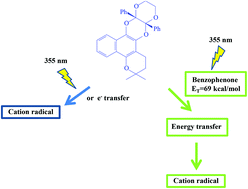Photophysics and photochemistry of the β-lapachone derived diphenyldihydrodioxin: generation and characterization of its cation radical†
Abstract
The photophysics and photochemistry of the β-lapachone derived diphenyldihydrodioxin 3 were investigated using steady-state and time resolved techniques. Laser excitation of 3 leads to the formation of its cation radical 4 (absorption maxima at 410 and 450 nm and a lifetime of 10 μs), which was confirmed by its thermal generation employing tris(2,4-dibromophenyl)-aminium hexachloroantimonate (BAHA) as the electron acceptor. The cation radical 4 was also formed via the triplet excited state of 3 through a triplet sensitized process using benzophenone (ET = 69 kcal mol−1) as the sensitizer.


 Please wait while we load your content...
Please wait while we load your content...